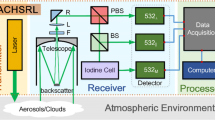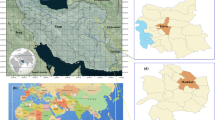Abstract
Clouds and aerosols can significantly affect global climate change and the atmospheric environment, and observing them three-dimensionally with high spatial and temporal resolutions is a long-standing issue. Spaceborne lidars are effective instruments for the vertical detection of clouds and aerosols globally. Numerous Mie scattering lidars were successfully launched and widely used, such as the Cloud-Aerosol Lidar with Orthogonal Polarization (CALIOP) and Geoscience Laser Altimeter System. However, the retrieval of Mie scattering lidar data is an ill-posed problem that introduces a large uncertainty. The spaceborne Aerosol and Cloud High Spectral Resolution Lidar (ACHSRL) of China is currently under development and scheduled for launch in the near future. The ACHSRL attracted extensive attention, because it can separate Mie and Rayleigh scattering signals and avoid ill-posed retrieval. In this study, we conducted ACHSRL signal simulation and retrieval to explore the potential of the ACHSRL. First, we proposed a simplified scheme for retrieving optical parameters, which reduced the number of equations and intermediate variables of the traditional method and avoided false extrema in the backscatter coefficient retrieval. Additionally, the experiments showed that the backscatter coefficient retrieval was overestimated owing to the influence of the Poisson noise but can be corrected. Second, we examined the feasibility of the strategy of “first retrieving the lidar ratio then retrieving the extinction coefficient” to improve the extinction coefficient retrieval. We found that the retrieval error in the simulated cases can be reduced to less than 1% of the original retrieval error. Furthermore, we discussed the influence of the uncertainty of the iodine filter transmittance on the retrieval of the optical parameters and found that the average relative error was less than 1‰. Finally, we conducted simulation and retrieval based on the atmospheric parameters measured by the CALIOP. Results showed that the relative error in the backscatter and extinction coefficients at night was 12% and 28% for test cases, respectively, which was superior to that in the backscatter and extinction coefficients of the corresponding CALIOP product (i.e., 75% and 82%). This research is significant and useful for the development and application of satellite lidars in the future.
Similar content being viewed by others
References
Bu L, Wang Q, Xu J, Zhu S, Liu J, Tian L. 2020. Validation of an airborne high spectral resolution lidar and its measurement for aerosol optical properties over Qinhuangdao, China. Opt Express, 28: 24471
Cairo F, Di Donfrancesco G, Adriani A, Pulvirenti L, Fierli F. 1999. Comparison of various linear depolarization parameters measured by lidar. Appl Opt, 38: 4425–4432
Chen L F, Chen S S, Zhong L J, Tao J H, Wang Z F. 2015. Statistic method of particulate matter concentration based on the satellite observations combining with ground measurements in PRD (in Chinese). Trop Geogr, 35: 7–12
Cheng Z T. 2017. High-spectral-resolution lidar based on field-widened michelson interferometer (in Chinese). Dissertation for Doctoral Degree. Hangzhou: Zhejiang University. 1–130
Cheng Z T, Liu D, Luo J, Yang Y Y, Su L, Yang L M, Huang H L, Shen Y L. 2014. Effects of spectral discrimination in high-spectral-resolution lidar on the retrieval errors for atmospheric aerosol optical properties. Appl Opt, 53: 4386
Chepfer H, Noël V, Chiriaco M, Wielicki B, Winker D, Loeb N, Wood R. 2018. The potential of a multidecade spaceborne lidar record to constrain cloud feedback. J Geophys Res-Atmos, 123: 5433–5454
Di H, Hua H, Cui Y, Hua D, He T, Wang Y, Yan Q. 2017. Vertical distribution of optical and microphysical properties of smog aerosols measured by multi-wavelength polarization lidar in Xi’an, China. J Quant Spectrosc Ra, 188: 28–38
Dong J, Liu J, Bi D, Ma X, Zhu X, Zhu X, Chen W. 2018. Optimal iodine absorption line applied for spaceborne high spectral resolution lidar. Appl Opt, 57: 5413
Dong J, Liu J, Zhu X, Bi D, Zhu X, Chen W. 2019a. Splitting ratio optimization of spaceborne high spectral resolution lidar (in Chinese). Infrared Laser Eng, 48: 7–12
Dong J, Liu J, Zhu X, Decang B I, Zhu X. 2019b. Error analysis of spaceborne high spectral resolution lidar. Optical Sensing and Imaging Technology and Application, doi: https://doi.org/10.1117/12.2505030
Esselborn M, Wirth M, Fix A, Tesche M, Ehret G. 2008. Airborne high spectral resolution lidar for measuring aerosol extinction and back-scatter coefficients. Appl Opt, 47: 346–358
Gao F, Nan H S, Huang B, Wang L, Li S C, Wang Y F, Liu J J, Yan Q, Song Y H, Hua D X. 2018. Technical realization and system simulation of ultraviolet multi-mode high-spectral-resolution lidar for measuring atmospheric aerosols (in Chinese). Acta Phys Sin, 67: 48–58
Gatt P, Henderson S W. 2001. Laser radar detection statistics: A comparison of coherent and direct-detection receivers. Orlando: Proceedings of SPIE-The International Society for Optical Engineering. 4377: 251–262
Guo J, Liu H, Wang F, Huang J, Xia F, Lou M, Wu Y, Jiang J H, Xie T, Zhaxi Y, Yung Y L. 2016. Three-dimensional structure of aerosol in China: A perspective from multi-satellite observations. Atmos Res, 178–179: 580–589
Hasinoff S W. 2014. Photon, Poisson Noise. New York: Springer US
Illingworth A J, Barker H W, Beljaars A, Ceccaldi M, Chepfer H, Clerbaux N, Cole J, Delanoë J, Domenech C, Donovan D P, Fukuda S, Hirakata M, Hogan R J, Huenerbein A, Kollias P, Kubota T, Nakajima T, Nakajima T Y, Nishizawa T, Ohno Y, Okamoto H, Oki R, Sato K, Satoh M, Shephard M W, Velázquez-Blázquez A, Wandinger U, Wehr T, van Zadelhoff G J. 2015. The EarthCARE satellite: The next step forward in global measurements of clouds, aerosols, precipitation, and radiation. Bull Am Meteorol Soc, 96: 1311–1332
Kovalev V A. 2015. Solutions in lidar profiling of the atmosphere. Hoboken: John Wiley & Sons
Li Z, Guo J, Ding A, Liao H, Liu J, Sun Y, Wang T, Xue H, Zhang H, Zhu B. 2017. Aerosol and boundary-layer interactions and impact on air quality. Natl Sci Rev, 4: 810–833
Liu B Y, Zhuang Q F, Qin S G, Wu S H, Liu J T. 2017. Aerosol classification method based on high spectral resolution lidar (in Chinese). Infrared Laser Eng, 46: 232–244
Liu D, Yang Y Y, Zhou Y D, Huang H L, Cheng Z T, Luo J, Zhang Y P, Duan L L, Shen Y B, Bai J, Wang K W. 2015. High spectral resolution lidar for atmosphere remote sensing: A review (in Chinese). Infrared Laser Eng, 44: 2535–2546
Liu D, Zheng Z, Chen W, Wang Z, Li W, Ke J, Zhang Y, Chen S, Cheng C, Wang S. 2019. Performance estimation of space-borne high-spectral-resolution lidar for cloud and aerosol optical properties at 532 nm. Opt Express, 27: A481
Liu J, Chen W, Liu Z. 2003. A simulation of simultaneously measuring wind and aerosol optical properties using high spectral resolution lidar (in Chinese). Chin J Atmos Sci, 27: 115–122
Liu J, Chen W, Song X. 2010. Theory of iodine filter based on high spectral resolution lidar (in Chinese). Acta Opt Sin, 30: 1548–1553
Liu Z S, Wu D, Liu J T, Zhang K L, Chen W B, Song X Q, Hair J W, She C Y. 2002. Low-altitude atmospheric wind measurement from the combined Mie and Rayleigh backscattering by Doppler lidar with an iodine filter. Appl Opt, 41: 7079–7086
Lu N M, Min M, Dong L X, Guo J P, Niu T, Liu H L, Bi Y M, Wang X, Chen L, Wu X B. 2016. Development and prospect of spaceborne LiDAR for atmospheric detection (in Chinese). Natl Remote Sens Bull, 20: 1–10
Lux O, Lemmerz C, Weiler F, Marksteiner U, Witschas B, Rahm S, Schäfler A, Reitebuch O. 2018. Airborne wind lidar observations over the North Atlantic in 2016 for the pre-launch validation of the satellite mission Aeolus. Atmos Meas Tech, 11: 3297–3322
Ma P L, Rasch P J, Chepfer H, Winker D M, Ghan S J. 2018. Observational constraint on cloud susceptibility weakened by aerosol retrieval limitations. Nat Commun, 9: 2640
Noaa U, Force U A. 1976. US standard atmosphere, 1976. NOAA-S/T
Omar A H, Winker D M, Kittaka C, Vaughan M A, Liu Z, Hu Y, Trepte C R, Rogers R R, Ferrare R A, Lee K P, Kuehn R E, Hostetler C A. 2009. The CALIPSO automated aerosol classification and LIDAR ratio selection algorithm. J Atmos Ocean Tech, 26: 1994–2014
Sasano Y, Kobayashi T. 1995. Feasibility study on space lidars for measuring global atmospheric environment. Tokyo: Optoelectronic Industrg and Technology Development Association. F–82
Sioris C E, McLinden C A, Shephard M W, Fioletov V E, Abboud I. 2017. Assessment of the aerosol optical depths measured by satellite-based passive remote sensors in the Alberta oil sands region. Atmos Chem Phys, 17: 1931–1943
Song X Q, Guo J J, Yan Z A, Zhang K L, Li Z G, Liu Z S. 2008. Detection of aerosol optical parameters by hyperspectral Resolution Lidar (in Chinese). Prog Nat Sci, 18: 1009–1015
Wang Z F, Li J, Wang Z, Yang W Y, Tang X, Ge B Z, Yan P Z, Zhu L L, Chen X S, Chen H S, Wand W, Li J J, Liu B, Wang X Y, Wand W, Zhao Y L, Lu N, Su D B. 2014. Modeling study of regional severe hazes over mid-eastern China in January 2013 and its implications on pollution prevention and control. Sci China Earth Sci, 57: 3–13
Winker D M, Vaughan M A, Omar A, Hu Y, Powell K A, Liu Z, Hunt W H, Young S A. 2009. Overview of the CALIPSO mission and CALIOP data processing algorithms. J Atmos Ocean Tech, 26: 2310–2323
Xiao Y. 2018. Atmospheric characteristic analysis of spaceborne hyper-spectral resolution lidar return signal (in Chinese). Dissertation for Master’s Degree. Chengdu: Chengdu University of Information Technology
Xiao Y, Binglong C, Min M, Xingying Z, Lilin Y, Yiming Z, Lidong W, Fu W, Xiaobo D. 2018. Simulating return signals of a spaceborne high-spectral resolution lidar channel at 532 nm. Opt Commun, 417: 89–96
Zhang R H, Li Q, Zhang R N. 2014. Meteorological conditions for the persistent severe fog and haze event over eastern China in January 2013. Sci China Earth Sci, 57: 26–35
Zheng Z, Chen W, Zhang Y, Chen S, Liu D. 2020. Denoising the spaceborne high-spectral-resolution lidar signal with block-matching and 3D filtering. Appl Opt, 59: 2820
Zhong Z Q, Zhou J. 2003. Simulated signal calculation for micro pulse lidar (in Chinese). Chin J Quant Electron, 20: 618–622
Acknowledgements
We thank NASA for providing the CALIOP data (https://www-calipso.larc.nasa.gov/). This work was supported by the National Natural Science Foundation of China (Grant Nos. 41627804 & 41971285), the Natural Science Foundation of Hubei Province (Grant No. 2020CFA003), and the Fundamental Research Funds for the Central Universities (Grant No. 2042020kf0216).
Author information
Authors and Affiliations
Corresponding author
Rights and permissions
About this article
Cite this article
Mao, F., Luo, X., Song, J. et al. Simulation and retrieval for spaceborne aerosol and cloud high spectral resolution lidar of China. Sci. China Earth Sci. 65, 570–583 (2022). https://doi.org/10.1007/s11430-021-9842-x
Received:
Revised:
Accepted:
Published:
Issue Date:
DOI: https://doi.org/10.1007/s11430-021-9842-x




